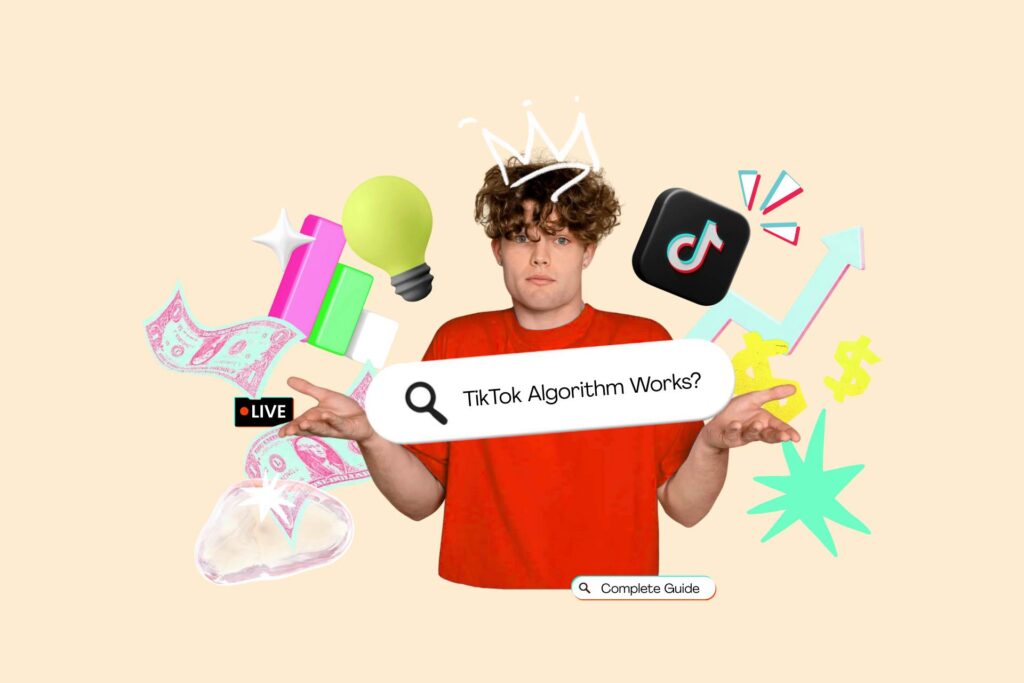TikTok’s recommendation system isn’t just smart anymore. It’s getting more smart. If you run a digital marketing agency or work in branding, this isn’t just interesting background noise. This is something to follow. And understanding it is the difference between “just posting content” and actually making an impact.
Let’s break it down.
1. The Four Signals That Actually Move the Needle
Interactions Still Rule the Feed
Likes, comments, shares, all important. But the most important factor? Watch time. Especially full plays and replays. If someone watches your video all the way through and comes back for seconds, TikTok sees that as a standing ovation. That’s gold.
Audio, Captions & Context
TikTok’s gotten better at understanding the mood and meaning behind your content. It’s not just reading hashtags anymore, it’s listening. Literally. Sound recognition helps it figure out the vibe (Is this funny? Chill? Dramatic?). And since TikTok is now basically a search engine, 40% of Gen Z treats it like one, your captions and spoken words are low-key SEO fuel.
AI Judging Your Content
There’s a newer layer of AI under the hood that evaluates quality. Not just views, but actual value. Does it make sense? Is it original? Reposts are getting buried, but creative remixes and clever edits still have life. So, don’t be lazy with recycled content. You’ll get ghosted by the algorithm.
Location & Device Data
These still matter, language, region, device type. But they’re more of a support act now. TikTok leans more on behavior signals than static info. That said, if you’re tailoring content for a specific city, region, or dialect, you’ve got an edge. Hyper-local is hyper-relevant.
2. Watch Time Is the Main Factor

Here’s the thing: watch time runs the show.
Buffer crunched numbers from over a million videos and found that clips longer than a minute pull in 63.8% more total watch time. TikTok noticed. Now, the algorithm rewards “longer short-form” content, stuff in that 60 to 90 second range, as long as people don’t scroll away.
And we’re not just talking about views. TikTok’s watching micro-signals: did someone pause? Rewind? Watch it twice? These small behaviors say, “Hey, this is good stuff.” That matters way more than passive scrolling.
3. Creator Consistency Means Algorithm Trust
TikTok doesn’t just love great content. It loves reliable creators.
Posting regularly? Sticking to a niche? You’re training the algorithm to trust you. It starts treating your uploads like safe bets. That means better reach and more visibility.
Verified accounts seem to get a minor boost, but if you’re unverified and post inconsistently or off-topic, expect to feel the squeeze.
4. TikTok’s Letting Users Steer the Feed
TikTok’s started handing users the remote.
Features like “Manage Topics” and smart keyword filters give people more control over what they want (or don’t want) to see. If someone opts out of “travel” content, guess what? Your travel vlog isn’t even entering the room.
On the backend, this behavior feeds back into the system. It helps the algorithm prioritize or mute content types across the platform. So, staying on-topic isn’t just about branding, it’s survival.
Also: TikTok is really over reposted content. It’s actively suppressing it. Keep it fresh, remix it, add value, or don’t bother.
5. The “First 200 Videos” Trap
There’s this interesting quirk in how TikTok feeds work, it’s what some are calling the “first 200 videos” effect. Whatever kind of content you interact with at the start of a session gets amplified like crazy. The longer you scroll, the narrower your feed becomes.
So, let’s say a user watches a couple of baking videos early on. Boom. They’re getting a whole buffet of cake-making tutorials for the next hour.
What does this mean for marketers? Simple: grab attention early. Reinforce your niche quickly. Don’t wait to get to the point, lead with it.
Why Marketing Agencies Need to Pay Attention
Alright, here’s where the rubber meets the road.

If you run a digital marketing or social media marketing agency, this algorithm isn’t something to fear. It’s your blueprint. This is where data meets creativity.
For digital marketers:
- Hook them in the first 2–3 seconds. No long build-ups.
- Test 60-90 second videos that actually hold attention.
- Make your captions work double duty, SEO and engagement.
For branding agencies:
- Authenticity wins. No more copy-paste content calendars.
- Think in series: micro-teasers, long-form breakdowns, recurring formats.
- Fresh angles beat overused trends. Every time.
Quickfire Strategy Checklist
| Step | What To Do |
| Define your niche | Stick to clear, specific themes. Repetition is recognition. |
| Hook them fast | Visual or verbal trigger in the first 3 seconds. No time to warm up. |
| Go long (strategically) | 60–90 sec videos if they actually tell a story. |
| Think metadata | Use keywords in captions, and speak them in the video too. |
| Be reactive | Reply to comments, post duets/stitches quickly (ideally within an hour). |
| Stay original | Reposting is dead. Remix and reframe instead. |
| Watch your metrics | Completion %, watch time, and comments per view are your compass. |
A Few 2025-Specific Updates You Shouldn’t Ignore

- TikTok is building a U.S.-only version of the app, with its own algorithm trained on American data. If you’re posting globally, this could change how your content travels.
- Mental health advocates are raising red flags, kids are getting hooked in under 35 minutes. Expect tighter algorithm controls for minors soon.
- “Smart Keyword Filter” and “Manage Topics” are now available worldwide. They’re no longer beta features.
So, What’s the Bottom Line?
The TikTok algorithm in 2025 isn’t unpredictable; it’s just complex. It rewards real engagement, consistent creators, and original content. It punishes laziness, clickbait, and anything that feels recycled.
If you’re in the branding agency world, this is your chance to lead. Marry creative storytelling with sharp analytics. Help clients show up in-feed with content that not only gets seen, but gets remembered.
Need help creating content that actually performs in this new TikTok landscape? Happy to help build a plan, craft a case study, or even brainstorm what a niche-specific strategy might look like. Just say the word.
Sources:
Buffer study (1.1 million TikToks; +63.8 % watch time for clips over 1 minute)
TikTok’s Algorithm Favors Longer Short-Form Videos, Study Finds
SocialMediaToday reporting on Buffer data
NetInfluencer article summarizing Buffer’s findings
Reuters on U.S.-only TikTok app (standalone algorithm and data)
MarketWatch (citing Reuters) on the U.S. app
Technode coverage on the U.S. app
FAQ
1. How does TikTok determine which videos to show on the For You page in 2025?
It all comes down to signals. TikTok looks at what you engage with, likes, comments, replays, even pauses and builds a real-time profile of your interests. It also analyzes the video itself: audio, captions, hashtags, and even tone. Once it knows what you like, it serves more of it. The For You page isn’t random—it’s a feedback loop tailored to each scroll.
2. How can I increase my reach using the TikTok algorithm in 2025?
Grab attention in the first 2–3 seconds. That’s non-negotiable. Then hold it, longer videos (60–90 seconds) perform well if people actually watch them through. Also, post consistently within a niche. The algorithm likes creators it can trust. And don’t sleep on your captions, keyword-rich text now plays a big role thanks to TikTok’s search-focused evolution.
3. How does engagement impact TikTok’s algorithm in 2025?
Engagement is still everything, but it’s deeper now. TikTok doesn’t just care that someone liked your video. It’s asking, Did they watch it till the end? Did they come back to it? Did they comment something meaningful? These micro-signals tell the algorithm your content is valuable and that’s what gets you boosted on more feeds.
4. How does the TikTok algorithm prioritize content in 2025?
The algorithm weighs a few core things: watch time (top dog), engagement signals (likes, comments, shares, replays), content quality (scored by AI), and consistency from the creator. If your video nails all four, you’re in great shape. Bonus points if it fits a niche the viewer’s already been digging into during that session.
5. Does the TikTok algorithm favor new or established accounts in 2025?
Honestly? It’s more about content than account age. New accounts can go viral if the video’s strong and hits the right signals. That said, established accounts that post regularly and stay on-topic do build what’s basically an “algorithm trust score.” So yes, consistency helps, but it’s not a closed club. Great content still breaks through.

